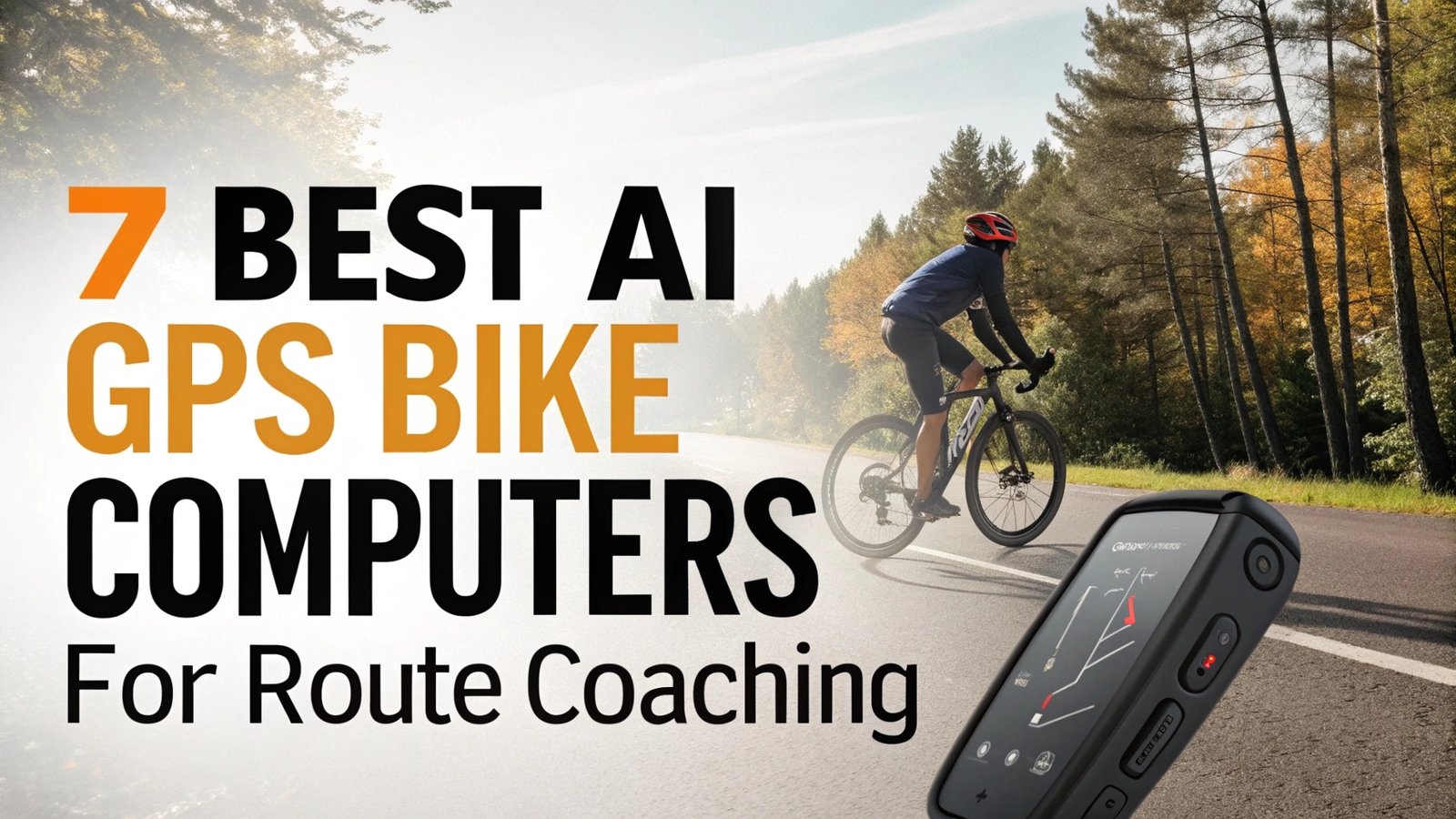7 Best AI GPS Bike Computers for Route Coaching in 2025
Modern cycling has entered the age of artificial intelligence. Smart GPS bike computers now offer revolutionary route coaching features that transform how cyclists navigate, train, and explore new terrains.
These advanced devices use machine learning algorithms to provide real-time guidance, adaptive training plans, and intelligent route optimization.
Today’s AI-powered bike computers go far beyond basic GPS tracking. They analyze your riding patterns, predict upcoming challenges, and automatically adjust coaching recommendations based on your performance data.

Key Takeaways:
- Smart Route Coaching transforms traditional navigation into an intelligent training partner. Modern AI bike computers analyze millions of data points to provide personalized route recommendations based on your fitness level, riding history, and performance goals.
- Predictive Analytics enable these devices to anticipate challenging sections of your route. They provide advance warnings about steep climbs, technical descents, and weather-related hazards, allowing you to prepare mentally and physically for what lies ahead.
- Adaptive Training Integration allows AI bike computers to automatically adjust workout intensity based on real-time performance data. The system learns from your responses to different training stimuli and continuously refines coaching recommendations for optimal results.
- Multi-Platform Connectivity ensures seamless integration with popular cycling apps like Strava, Komoot, and TrainingPeaks. These AI systems consolidate data from multiple sources to create comprehensive performance profiles and more accurate coaching algorithms.
- Real-Time Performance Optimization uses machine learning to identify inefficiencies in your riding technique, pacing strategies, and route choices. The AI provides instant feedback and corrections to help you ride more efficiently and achieve better results.
- Future-Proof Technology means these devices continuously improve through software updates. The AI algorithms become more sophisticated over time, learning from global user data to provide increasingly accurate and personalized coaching.
Garmin Edge 1050: The AI Navigation Powerhouse
The Garmin Edge 1050 represents the pinnacle of AI-powered cycling technology. This premium device features a stunning 3.5-inch color touchscreen and incorporates advanced machine learning algorithms for route optimization and performance coaching.
The Edge 1050’s AI-driven ClimbPro feature revolutionizes how cyclists approach challenging terrain. The system automatically detects upcoming climbs without requiring pre-loaded routes, providing detailed information about gradient percentages, remaining distance, and optimal pacing strategies. This predictive capability allows riders to manage energy reserves more effectively throughout demanding rides.
Smart navigation capabilities set this device apart from traditional GPS units. The AI system learns from millions of rider routes to suggest optimal paths based on traffic patterns, road surface quality, and elevation profiles. The device can automatically reroute in real-time when conditions change, ensuring you always take the most efficient path to your destination.
The advanced training load analysis uses artificial intelligence to monitor your fitness progression and prevent overtraining. The system analyzes heart rate variability, power output patterns, and recovery metrics to provide personalized recommendations for training intensity and recovery periods.
Pros:
- Massive 3.5-inch color touchscreen for excellent visibility
- AI-powered ClimbPro with automatic climb detection
- Advanced route optimization using machine learning
- Comprehensive training analytics with recovery guidance
- 64GB internal storage for extensive map data
- Multi-band GPS for superior accuracy
Cons:
- Premium price point may be prohibitive for casual riders
- Large size requires significant handlebar space
- Complex feature set may overwhelm beginner users
- Battery consumption increases with all features enabled
Garmin Edge 840: Intelligent Mid-Range Champion
The Garmin Edge 840 delivers professional-grade AI features in a more compact and affordable package. This device excels at targeted adaptive coaching, using machine learning to personalize training recommendations based on your individual performance patterns and goals.
Dynamic Performance Monitoring represents a significant advancement in cycling technology. The Edge 840’s AI algorithms continuously analyze your power output, heart rate, and cadence to identify areas for improvement. The system provides real-time coaching cues to help optimize your pedaling efficiency and energy distribution.
The device’s smart navigation system leverages crowd-sourced data from millions of Garmin users to recommend the most popular cycling routes in any area. This popularity routing feature ensures you discover scenic paths and cycling-friendly roads that might not appear on traditional maps.
Advanced physiological metrics powered by AI provide deeper insights into your fitness status. The system calculates VO2 max, training load, and recovery time using sophisticated algorithms that adapt to your individual response patterns. This personalized approach ensures training recommendations remain relevant as your fitness improves.
The touchscreen interface works flawlessly even in wet conditions and with gloves, making it practical for all-weather riding. The device’s compact form factor doesn’t compromise functionality while maintaining excellent readability during rides.
Pros:
- Targeted adaptive coaching with AI-driven recommendations
- Compact 2.6-inch touchscreen perfect for most handlebars
- Multi-band GPS for enhanced accuracy
- Excellent battery life up to 42 hours
- ClimbPro feature for intelligent climb management
- Comprehensive sensor connectivity
Cons:
- Smaller screen than premium models
- Limited onboard storage compared to flagship devices
- Navigation features less comprehensive than Edge 1050
- Premium features require additional sensors
Wahoo Elemnt Ace: The Wind-Sensing AI Innovation
The Wahoo Elemnt Ace introduces groundbreaking wind sensor technology combined with sophisticated AI algorithms for aerodynamic optimization coaching. This innovative device represents a quantum leap forward in cycling performance analysis and route guidance.
Wind Dynamics AI is the standout feature that analyzes real-time wind conditions and their impact on your performance. The system calculates optimal positioning recommendations and suggests strategic pacing adjustments based on headwind, tailwind, and crosswind conditions. This technology provides competitive advantages previously available only to professional cycling teams.
The device features the largest screen in Wahoo’s lineup at 3.8 inches, providing exceptional visibility for maps and data fields. The crisp color display remains easily readable in all lighting conditions, from bright sunlight to dawn and dusk riding.
Smart route planning integrates with popular platforms like Komoot and Strava to provide seamless navigation experiences. The AI system learns your preferred route characteristics and suggests similar paths in new areas. The device automatically syncs routes from your smartphone, eliminating the need for manual file transfers.
The user-friendly interface reflects Wahoo’s commitment to simplicity without sacrificing functionality. All device configuration happens through the intuitive smartphone app, making setup and customization significantly easier than competing products.
Pros:
- Revolutionary wind sensor technology for aerodynamic coaching
- Largest 3.8-inch display in Wahoo’s lineup
- Exceptional mapping quality with detailed visuals
- Simple setup process via smartphone app
- Excellent build quality and weather resistance
- Seamless app integration with major platforms
Cons:
- Large and heavy compared to compact alternatives
- Premium pricing reflects advanced technology
- Rerouting capabilities less reliable than competitors
- Wind sensor benefits may be limited for casual riders
Hammerhead Karoo 3: The Android-Powered AI Assistant
The Hammerhead Karoo 3 leverages the Android operating system to deliver smartphone-like functionality in a rugged cycling computer. This unique approach enables advanced AI capabilities and app-based customization that traditional bike computers cannot match.
Intelligent route discovery uses machine learning algorithms to analyze global riding patterns and suggest optimal routes based on surface quality, traffic levels, and scenic value. The system continuously updates recommendations as new data becomes available, ensuring you always discover the best possible riding experiences.
The device’s high-resolution color touchscreen provides exceptional map clarity with detailed topographic information. The responsive touch interface works reliably in all weather conditions, making mid-ride navigation adjustments quick and intuitive.
Smart integration capabilities allow the Karoo 3 to connect with virtually any cycling app or service. The Android platform enables advanced customization options and future expandability through software updates and new applications.
Performance analytics powered by AI provide comprehensive insights into your riding efficiency and fitness trends. The system identifies patterns in your training data and suggests specific improvements for power output, endurance, and technical skills.
The frequent software updates demonstrate Hammerhead’s commitment to continuous improvement. New features and AI enhancements are regularly delivered to existing devices, ensuring your investment remains current with evolving technology.
Pros:
- Android-based system enables advanced customization
- High-resolution 3.2-inch touchscreen with excellent clarity
- Frequent software updates with new AI features
- Exceptional mapping quality with detailed visuals
- Strong SRAM AXS integration for wireless drivetrains
- Responsive touch interface in all conditions
Cons:
- No Shimano Di2 support due to manufacturer restrictions
- Occasional software lag in menu navigation
- Higher power consumption than dedicated cycling computers
- Limited third-party app ecosystem compared to established platforms
Wahoo Elemnt Roam V3: The Simplified Smart Navigator
The Wahoo Elemnt Roam V3 emphasizes intelligent simplicity by combining advanced AI navigation features with Wahoo’s renowned ease-of-use philosophy. This device proves that sophisticated technology doesn’t require complex interfaces.
Smart navigation algorithms analyze crowd-sourced route data to provide optimal path recommendations based on road surface quality, traffic patterns, and cycling infrastructure. The AI system learns from millions of rides to suggest routes that prioritize cyclist safety and enjoyment.
The 2.7-inch color display strikes the perfect balance between screen size and device compactness. The 64-color screen provides clear visual distinction for different data types while maintaining excellent battery efficiency.
Dynamic data page configuration allows the AI system to automatically adjust displayed information based on riding conditions and phase of your workout. During climbing sections, the device prioritizes gradient and elevation data, while flat sections emphasize speed and power metrics.
Seamless smartphone integration enables effortless route sharing and real-time ride tracking. The Wahoo app automatically syncs your planned routes and provides detailed post-ride analysis with AI-generated insights and recommendations.
The device’s button-only interface eliminates touchscreen-related issues in wet conditions while maintaining quick access to all essential functions. This design philosophy prioritizes reliability over flashy features.
Pros:
- Perfect balance of features and simplicity
- Excellent 2.7-inch color display with good visibility
- Outstanding battery life for multi-day adventures
- Effortless smartphone integration and setup
- Reliable button interface works in all conditions
- Strong third-party app support
Cons:
- No touchscreen limits some navigation functions
- Smaller screen compared to premium alternatives
- Limited onboard route creation capabilities
- Basic training metrics compared to Garmin offerings
COOSPO CS500: The Budget AI-Enabled Option
The COOSPO CS500 democratizes AI-powered cycling technology by offering smart features at an accessible price point. This device proves that advanced navigation and coaching capabilities don’t require premium investment.
Intelligent route navigation provides turn-by-turn directions with automatic rerouting capabilities when you deviate from planned paths. The system uses basic AI algorithms to optimize route suggestions based on road type and cycling infrastructure availability.
The 2.6-inch LCD display offers clear visibility in various lighting conditions while maintaining impressive battery life. The screen automatically adjusts brightness based on ambient light conditions, ensuring optimal visibility without unnecessary power consumption.
Smart sensor connectivity supports ANT+ and Bluetooth protocols, enabling comprehensive performance monitoring with heart rate, power, and cadence sensors. The AI system analyzes this data to provide basic coaching insights and performance trends.
45-hour battery life makes this device ideal for long-distance touring and multi-day adventures. The auto-backlight feature helps preserve battery while ensuring visibility during dawn and dusk rides.
Route planning integration works with popular platforms like Komoot and Strava, allowing seamless import of planned routes and automatic synchronization of completed rides.
Pros:
- Exceptional value for AI-enabled features
- Impressive 45-hour battery life
- 2.6-inch clear LCD display
- Comprehensive sensor support
- Auto-backlight functionality
- Multiple mounting options included
Cons:
- Basic AI capabilities compared to premium models
- Limited advanced training metrics
- Monochrome display less appealing than color alternatives
- Smaller feature set for serious training applications
iGPSPORT BSC300T: The Touchscreen AI Companion
The iGPSPORT BSC300T combines touchscreen convenience with AI-powered navigation features in a competitively priced package. This device bridges the gap between basic cycling computers and premium smart navigation systems.
Smart offline mapping ensures reliable navigation even in areas with poor cellular coverage. The AI system pre-loads relevant map sections based on your planned route and historical riding patterns, ensuring continuous guidance throughout your adventures.
The touchscreen interface provides intuitive interaction with maps and data screens while maintaining reliable operation in various weather conditions. The responsive touch controls make mid-ride adjustments quick and straightforward.
Intelligent course warnings alert you to upcoming turns, hazards, and points of interest using predictive algorithms that analyze your speed and position relative to route features. This proactive approach helps prevent missed turns and navigation errors.
Multi-platform compatibility ensures seamless integration with popular cycling apps and easy route sharing between devices. The system automatically uploads completed rides to your preferred platforms for comprehensive performance tracking.
Advanced sensor support includes Insta360 camera integration, enabling automated recording during specific ride segments or when interesting features are detected by the AI system.
Pros:
- Responsive touchscreen interface
- Offline mapping capabilities for remote areas
- Competitive pricing for included features
- Insta360 camera integration
- Multi-platform app compatibility
- IPX7 waterproof rating
Cons:
- Limited brand recognition and support network
- Basic AI features compared to established competitors
- Smaller screen than premium alternatives
- Potential software update delays
Understanding AI Route Coaching Technology
Artificial Intelligence in cycling computers represents a fundamental evolution from passive data recording to active performance coaching. Modern AI systems analyze millions of data points from your rides, weather conditions, terrain features, and physiological responses to create personalized coaching recommendations.
Machine learning algorithms continuously improve their understanding of your unique riding characteristics. The system learns your preferred cadence ranges, power output patterns, and response to different training stimuli. This accumulated knowledge enables increasingly accurate predictions about optimal pacing strategies and training progressions.
Predictive analytics allow AI-powered bike computers to anticipate challenging sections of your route before you encounter them. The system analyzes elevation profiles, historical weather patterns, and crowd-sourced difficulty ratings to provide advance warnings and strategic recommendations for upcoming challenges.
Real-time adaptation ensures coaching recommendations remain relevant as conditions change during your ride. If headwinds increase or your power output declines, the AI system automatically adjusts pacing suggestions and route recommendations to help you achieve your ride objectives.
Essential Features of Modern AI Bike Computers
Multi-band GPS technology provides unprecedented location accuracy by utilizing multiple satellite constellations simultaneously. This enhanced precision enables AI systems to make more accurate route calculations and provide reliable navigation guidance even in challenging environments like dense forests or urban canyons.
Advanced sensor integration allows AI bike computers to collect comprehensive performance data from power meters, heart rate monitors, cadence sensors, and environmental monitors. This rich data foundation enables sophisticated algorithms to identify performance trends and optimize training recommendations.
Cloud connectivity ensures your AI bike computer benefits from global riding data and continuous algorithm improvements. Updates delivered over WiFi enhance navigation accuracy, expand mapping coverage, and introduce new coaching features without requiring hardware changes.
Smartphone integration creates a seamless ecosystem between your bike computer, training apps, and social platforms. AI systems can analyze data from multiple sources to provide more comprehensive insights and better coaching recommendations than any single device could achieve independently.
Training Benefits of AI-Powered Coaching
Personalized workout recommendations eliminate the guesswork from training progression. AI algorithms analyze your historical performance data, current fitness level, and specified goals to generate specific workout prescriptions that optimize adaptation while preventing overtraining.
Real-time pacing guidance helps you maintain optimal effort levels throughout varying terrain and conditions. The AI system continuously calculates the most efficient power distribution based on remaining distance, elevation profile, and your current physiological state.
Recovery optimization uses advanced analytics to determine when you’re ready for increased training loads and when additional rest is needed. The system monitors heart rate variability, sleep quality, and training stress to prevent burnout and maximize adaptation.
Performance trend analysis identifies subtle changes in your fitness level that might not be immediately apparent. AI algorithms can detect early signs of fatigue, overtraining, or fitness improvements weeks before they become obvious through traditional metrics.
Navigation Advantages of Smart Route Systems
Dynamic rerouting capabilities ensure you never get permanently lost even when exploring unfamiliar territories. AI systems instantly calculate alternative routes when you deviate from planned paths, considering real-time traffic conditions and road closures to provide optimal alternatives.
Heat map integration reveals popular cycling routes that might not appear on traditional maps. The AI system analyzes millions of rides from other cyclists to identify scenic paths, safe road choices, and interesting destinations that enhance your riding experience.
Weather-aware routing considers current and forecasted conditions when suggesting route options. The system can recommend covered paths during rain, shaded routes during extreme heat, or wind-protected alternatives during challenging weather conditions.
POI discovery helps you find cycling-friendly businesses, rest stops, and scenic viewpoints along your route. AI algorithms learn your preferences for coffee shops, bike shops, or scenic overlooks and automatically suggest relevant stops during longer rides.
Battery Life and Power Management
Intelligent power management ensures your AI bike computer maintains essential functions throughout extended rides. Smart algorithms automatically adjust screen brightness, GPS polling rates, and processor speeds to maximize battery life without compromising core functionality.
Solar charging integration in premium models extends operational time significantly during sunny conditions. These systems continuously top up the battery during daylight hours, enabling multi-day adventures without external charging.
Power saving modes allow you to prioritize specific functions when battery levels become critical. You can maintain navigation capabilities while reducing data recording or preserve core functions while disabling non-essential features.
External charging options provide flexibility for ultra-long adventures. Many AI bike computers support charging while in use, enabling unlimited operational time when connected to external battery packs or dynamo charging systems.
Future of AI in Cycling Technology
Emerging technologies promise even more sophisticated coaching capabilities in future AI bike computers. Integration with wearable health monitors, environmental sensors, and vehicle-to-infrastructure communication will provide unprecedented insights into cycling performance and safety.
Predictive maintenance will help cyclists identify potential mechanical issues before they cause problems. AI systems will monitor power meter irregularities, shifting patterns, and sensor data to predict component wear and recommend preventive maintenance.
Group ride optimization will coordinate AI coaching across multiple devices to enhance team performance and improve group safety. These systems will share real-time data between riders to optimize formations, pacing strategies, and route choices for entire groups.
Environmental adaptation will enable AI systems to automatically adjust recommendations based on altitude, air quality, temperature, and humidity changes. This physiological awareness will help cyclists maintain optimal performance across diverse environmental conditions.
Frequently Asked Questions
What makes AI route coaching different from regular GPS navigation?
AI route coaching goes far beyond simple turn-by-turn directions. While traditional GPS navigation provides basic routing from point A to point B, AI systems analyze your fitness level, riding history, and performance goals to create personalized route recommendations. These intelligent systems predict challenging sections, suggest optimal pacing strategies, and automatically adjust recommendations based on real-time conditions and your physiological responses.
Do AI bike computers work without internet connectivity?
Yes, most AI bike computers function fully offline once initial setup is complete. These devices store comprehensive mapping data locally and use onboard processing power for AI calculations. However, internet connectivity enhances functionality by enabling real-time traffic updates, weather integration, and access to crowd-sourced route data. The AI algorithms continuously improve through cloud updates when connectivity is available.
How accurate are AI-powered training recommendations?
AI training recommendations become increasingly accurate as the system learns your unique physiological responses and performance patterns. Initial recommendations are based on general population data and basic metrics, but accuracy improves significantly after several weeks of data collection. Advanced algorithms analyze power output, heart rate variability, and recovery patterns to provide personalized coaching that rivals professional training plans.
Can AI bike computers help improve cycling safety?
Absolutely, AI bike computers significantly enhance cycling safety through multiple mechanisms. Predictive hazard warnings alert you to upcoming traffic conflicts, road surface changes, and weather-related dangers. Smart routing algorithms prioritize cycling-friendly roads and paths while avoiding high-traffic areas when possible. Crash detection features automatically notify emergency contacts and provide GPS coordinates if accidents occur.
How long does it take for AI systems to learn my riding preferences?
Most AI bike computers begin providing useful recommendations within 2-3 weeks of regular use, but full personalization develops over 2-3 months. Basic preferences like preferred route types and intensity levels are learned quickly, while sophisticated physiological modeling requires more extensive data collection. The learning process accelerates when you import historical data from other cycling apps and devices.
Are AI bike computers worth the investment for casual cyclists?
AI bike computers offer significant value even for recreational riders. Smart navigation features help you discover new routes and avoid getting lost, while basic coaching functions can help you ride more efficiently and enjoyably. Budget-friendly options like the COOSPO CS500 provide essential AI features without premium pricing, making intelligent cycling technology accessible to riders at all levels.

I’m Liza, the founder and author of Liza AI Blog, where I share my passion for artificial intelligence through insightful guides and updates. I’m dedicated to making AI accessible to everyone, and I strive to create a community that’s both informed and engaged. Through my blog, I aim to promote a deeper understanding and appreciation of AI and its potential to shape our future. You can reach me at lizaaiblog@gmail.com or follow me on social media to stay updated on the latest AI news and trends.







